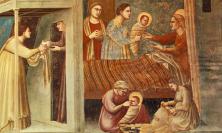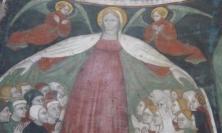On 1 January, we celebrate the Solemnity of Mary, Mother of God. It may seem like a simple or even obvious name to give to Mary, but the controversies that beset the development of this particular devotion reveal otherwise. Dorian Llywelyn SJ explores the enduring significance of this ancient feast, the title of which ‘contains the whole mystery of the Incarnation.’
Manchester University’s John Rylands Library is the home of a fragment of Egyptian papyrus. ‘Rylands 470’, as the library’s catalogue calls this fragile manuscript, measures merely some seven inches by two. On it is written in Greek the words ‘Mother of God, hear my supplications: suffer us not to be in adversity, but deliver us from danger. Thou alone…’ Probably written for personal prayer, this is an early version of a Marian prayer which Catholics know as Sub tuum praesidium or ‘Beneath thy protection.’ Experts date Rylands 470 to the middle of the third century AD. This tiny papyrus is of great importance for understanding how early Christians regarded the Virgin Mary. It allows us to surmise reasonably that by 250 or so, Christians in Egypt had already been venerating the mother of Jesus for some time and seeking her protection.
The historian and theologian Jaroslav Pelikan explained Theotokos – the Greek word we translate as ‘Mother of God’ – as meaning ‘the one who gave birth to the one who was God.’ Where Jesus had asked ‘who do people say I am?’, succeeding centuries were driven by the question ‘what do we say he is?’ as Christians struggled to understand and explain what it meant for the Word to take flesh. Is Jesus divine in the same sense that the Father is divine? Human in the same way that you and I are human? These were no abstract, arcane questions, for how people understood the who and what of Jesus also shaped their ideas of salvation and indeed of Christian life. The precise relationship between the divine and the human in Jesus was also a template for what it meant to be simultaneously Christian and human, or a member of the Church and a citizen of the Empire.
In the first decades of the fifth century, in an atmosphere of deep thought and often fervid debate, the role of Jesus’s mother became a matter of controversy. To refer to Mary as ‘Mother of God’ was – and indeed is still for some people – potentially scandalous. How can a woman, merely part of creation, give birth to the Creator? Bishop Nestorius of Constantinople (c.386-450) argued that the title Theotokos meant that the whole Godhead had been born as a man – an idea he found repugnant. How could a woman give birth to God? Nestorius’s suggestion that Mary should be addressed instead as Christotokos (‘Mother of the Christ’) or Anthropotokos (‘Mother of the Man’) was bitterly opposed by his arch-nemesis, the wily Cyril, Bishop of Alexandria and by the redoubtable empress Pulcheria, who sought to live her life in imitation of Mary. Nestorius’s opponents saw in his rejection of the Virgin’s title a refusal to accept the unity of the human and the divine in Jesus. The implication was that the life of heaven had nothing to do with the things of earth. But equally, Nestorius was also refuting the faith of the people and a venerable tradition: by that point, Christians had been addressing the Virgin Mary as ‘Mother of God’ for at least two centuries. These theological differences threatened the unity of the Church and the empire alike.
To calm the tensions, the Emperor Theodosius convened an ecumenical council at Ephesus in 431. The bishops gathered there voted to condemn Nestorius’s position. As a result, the title Theotokos (or its translation into other languages) remains the standard and most important way in Eastern Christianity of referring to the mother of Jesus.
The phrase ‘Mother of God’ and the Solemnity that the Catholic world celebrates on New Year’s Day appears at first glance to say little beyond the fact that Mary was the mother of Jesus. Yet in the same way that Mary’s womb ‘contained the God whom the universe cannot contain‘, as the Orthodox liturgical texts for Christmas say, her title ‘Mother of God’ contains whole worlds of meaning. The paradox of the Incarnation is, as a medieval English carol says, ‘heaven and earth in little space.’ Simply put, to call Mary ‘Mother of God’ states that her Son was divine. To say that Mary was a ‘birth-giver’ says that the divine Son was ‘born of a woman’ (Gal 4:4) and thus fully human. The phrase is a summary of the foundational belief that the ‘Word became flesh and pitched his tent amongst us’ (John 1:14). St John of Damascus, writing in the first half of the eighth century and summing up the teaching of the earlier Church Fathers, says that the title Theotokos ‘contains the whole mystery of the Incarnation.’
The decision of the Council of Ephesus spurred devotion to the Mother of God throughout the Roman Empire. Only a few years after the debates, Pope Sixtus III built the Roman basilica of Santa Maria Maggiore, one of the first churches dedicated to Mary. Over the centuries, there gradually accumulated a deepening vision of the person and role of the Virgin, expressed in a complex matrix of theological speculation, public and private worship, legendary narratives, miracle stories, homilies and hymns, buildings and images. The most famous of early hymns to Mary, the Akathistos, attributed to Romanos the Melodist (c.490-556), addresses her not only as Theotokos but with hundreds of titles that place her – or rather, strictly speaking, the fact that she had given birth to the Saviour – at the centre of all history. The unparalleled stature of Mary grew, venerated as the crown of all creation and a figure to whom the faithful could seek recourse in troubled times.
Even before Ephesus, Marian feasts had found their way into the liturgy of the Church. Other Marian celebrations, modeled on the feasts commemorating the life, death and resurrection of Jesus, were introduced into the church calendars in Constantinople and Jerusalem. When the Christmas Octave developed in Rome in the 7th century, the Virgin Mother of God was given her own special feast, the Natale Sanctae Mariae (the Commemoration of Holy Mary) celebrated on 1 January, at the end of the Christmas Octave. The Solemnity that opens our calendar year is thus the most ancient Marian feast of all.
Older Catholics might remember 1 January, however, as the feast of the Circumcision. As the Marian feasts of the Annunciation and the Assumption began to be celebrated annually, emphases had shifted. By the fourteenth century, 1 January was being celebrated as the Circumcision of the Lord and the Octave of Christmas. Despite the change of title, this was nonetheless a feast replete with readings and prayers involving Mary. In 1969, the revision of the Roman Calendar restored the original focus of the day, declaring that ‘1st January, the Octave Day of the Nativity of the Lord, is the Solemnity of Mary, the Holy Mother of God, and also the commemoration of the conferral of the Most Holy Name of Jesus.’
Yet you might reasonably ask, what do these historical and theological minutiae have to do with 1 January 2016? Vatican II teaches us that in the work of salvation, the union of the Mother of God with her Son is ‘made manifest from the time of Christ's virginal conception up to His death’ (Lumen Gentium §57). An ancient understanding of the Crucifixion scene of the Gospel of John – an instinct older even than Rylands 470 – interprets the words of Jesus to his mother and to the beloved disciple to mean that that the love between mother and son is now extended to all disciples: the Mother of God is also and inseparably Mother of the Church. Yet in the last 50 or so years, Catholics’ devotion to the Mother of God has, at least in some quarters, declined or become an inessential extra to a healthy faith-life. In these more ecumenically-sensitive times, when Mary can be like her Son, a sign of contradiction, the mother of Jesus has sometimes faded from awareness. Yet to know and love Jesus requires that we also know and love Mary. Or, as the Orthodox theologian Fr. Georges Florovsky put it, ‘to ignore the Mother means to misinterpret the Son.’ Yet even when Christians are not present to her, the Mother of God remains constantly present to her Church.
Blessed Paul VI’s 1967 Exhortation on Marian devotion, Marialis Cultus, tells us that this Solemnity ‘is meant to commemorate the part played by Mary in this mystery of salvation (the Incarnation) and also to exalt the singular dignity which this mystery brings to the holy Mother...through whom we were found worthy to receive the Author of life.’ That ‘mystery of salvation’ is in effect like a brilliant diamond, where each facet, reflects the whole. All the differing names and emphases of the Church’s feasts for 1 January reflect what is the same, profound truth of the Incarnation – a mystery in which Mary has a unique, central role.
The title Theotokos arose first from from the spiritual instincts of generations of Christians, who experienced the effects of the Virgin’s intercession as fruit of the Incarnation. Later thinkers expressed the same idea in more intellectual terms. The Catechism teaches us: ‘What the Catholic faith believes about Mary is based on what it believes about Christ, and what it teaches about Mary illumines in turn its faith in Christ’ (487). Prayer and doctrine alike express the fact that to venerate Mary as Mother of God is also to honour and love her Son.
In the same way, celebrating the Circumcision at the Christmas Octave, as the Church did for centuries, emphasises the reality that Jesus was a Jew. His Jewishness, inherited from his mother, is the expression and the guarantee of his real human existence. Through the Virgin Mother, we have a fully human Saviour who experienced hunger, anger, loneliness and tiredness as well as intimacy with his heavenly Father, and who can thus sympathise with us in our weaknesses. Moreover, the baby that Mary held in her arms at the temple is the long-awaited Messiah, the fulfillment of the centuries of waiting and hoping: the aged Simeon recognises Jesus as the light of the Gentiles and the glory of God’s people. To commemorate the giving of a name to Mary’s son also reminds us of his Jewish background, but in addition reflects Mary’s obedience to the command of the Archangel to call her son Jesus. In the Jewish mind, the name encapsulates the deep identity of a person: Yeshua, the Hebrew original of the name Jesus, means ‘The Lord saves.’ The Virgin’s Son is also named Emmanuel, God-with-us, God’s fidelity to his creation made man. And in the Jesuit world, the Solemnity of the Most Holy Name of Jesus (which also used to be celebrated at the Christmas Octave but has now moved to 3 January) has a special resonance: the Society takes its name from Jesus and has adopted the Christogram IHS – the first three letters of the Greek form of Yeshua – as its own emblem.
One last facet of this Solemnity demands our attention. New Year’s Day 2016 will be celebrated by a troubled world which seems to be more filled with violence and tension than for many years past. In 1968, Paul VI designated 1 January as an annual World Day of Peace. His words in Marialis Cultus remain particularly poignant: ‘This is a fitting occasion for renewing adoration of the newborn Prince of Peace, for listening once more to the glad tidings of the angels (cf. Lk. 2:14), and for imploring from God, through the Queen of Peace, the supreme gift of peace.’ This year, as ever, the Church prays that the Mother of God and the Mother of Church will hear our supplications, suffer us not to be in adversity but deliver all the nations of the earth from danger.
Dorian Llywelyn is a Welshman and a member of the California Province of the Society of Jesus. He is currently teaching systematic theology at Heythrop College, University of London, and superior of the Brixton Jesuit Community.






